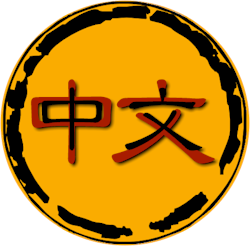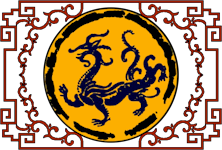
The Chinese language is the oldest continuously written and spoken language in the world. It is spoken by more people than any other. The written language is used by more people than those who use English, Spanish, German and French, combined.
The written language, such as in the image to the left, is comprised of characters and is considered a pictographic language, in the strictest sense.
For example, the name for China is Zhong-guo. It is made of two characters; the first character zhōng (![]() ) means "central" or "middle". The second character guó (
) means "central" or "middle". The second character guó (![]() ) means "kingdom" or "nation". The term can be literally translated into English as "Middle Kingdom" or "Central Kingdom." Zhōng (
) means "kingdom" or "nation". The term can be literally translated into English as "Middle Kingdom" or "Central Kingdom." Zhōng (![]() ) is comprised of a region, which is equally divided; thus the division occurs in the 'middle' of the region being depicted. Guó (
) is comprised of a region, which is equally divided; thus the division occurs in the 'middle' of the region being depicted. Guó (![]() ) is comprised of a house, an army, a population of people and food within a box, or boarder; thus everything within the border is considered elements of a country.
) is comprised of a house, an army, a population of people and food within a box, or boarder; thus everything within the border is considered elements of a country.
While the written language is universal in the entire country, the spoken language is not. There are several dialects of the same language. Mandarin is the official national language, with Yue and Wu dialects being the second and third most widely used, respectively. Yue is often referred to as Cantonese, spoken in areas around Hong Kong, Guangzhou and Guangdong. Wu is spoken in Shanghai, Anhui and Zhejiang areas.
The spoken languages of China are all tonal, which means multiples of the same sound component can be used for different characters, depending on the tone of the component. The closest thing English can relate to is the use of punctuation. Questions, for example, tend to end in a higher tone than statements indicated with a period.
In cases where the same tone is used for multiple characters, the determining factor of definition may be a preceding character indicating context. For example, when we say 'straight as an arrow' to indicate something that has no curvature, the context is understood to mean that a comparison is being made, since there are no arrows around and nobody in the conversation is practicing archery, nor going to war. In Chinese, however, a linguistic context must be explicitly formed in order to indicate the comparison. In Chinese, one might say that the flag pole is as un-curving as the wood made form an arrow used in war. Such comparisons would be considered cumbersome Chinese, due to the already metaphorical nature of the language. The Chinese language allows a thought or idea to be communicated using very few 'words'.
